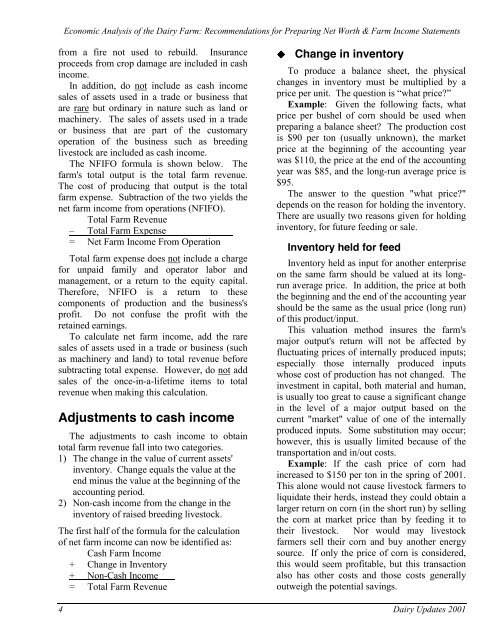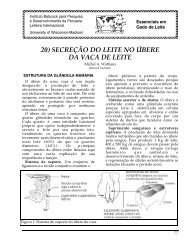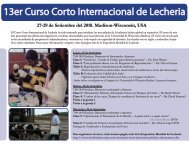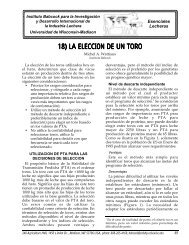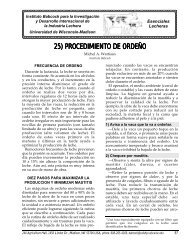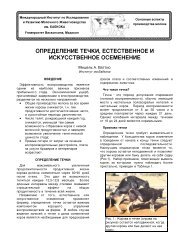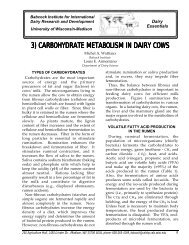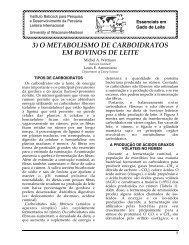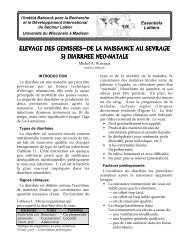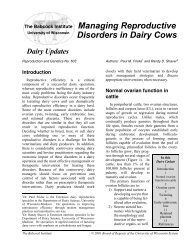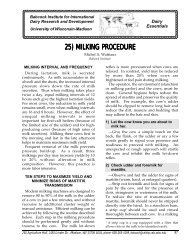Economic Analysis of the Dairy Farm - Babcock Institute - University ...
Economic Analysis of the Dairy Farm - Babcock Institute - University ...
Economic Analysis of the Dairy Farm - Babcock Institute - University ...
You also want an ePaper? Increase the reach of your titles
YUMPU automatically turns print PDFs into web optimized ePapers that Google loves.
<strong>Economic</strong> <strong>Analysis</strong> <strong>of</strong> <strong>the</strong> <strong>Dairy</strong> <strong>Farm</strong>: Recommendations for Preparing Net Worth & <strong>Farm</strong> Income Statementsfrom a fire not used to rebuild. Insuranceproceeds from crop damage are included in cashincome.In addition, do not include as cash incomesales <strong>of</strong> assets used in a trade or business thatare rare but ordinary in nature such as land ormachinery. The sales <strong>of</strong> assets used in a tradeor business that are part <strong>of</strong> <strong>the</strong> customaryoperation <strong>of</strong> <strong>the</strong> business such as breedinglivestock are included as cash income.The NFIFO formula is shown below. Thefarm's total output is <strong>the</strong> total farm revenue.The cost <strong>of</strong> producing that output is <strong>the</strong> totalfarm expense. Subtraction <strong>of</strong> <strong>the</strong> two yields <strong>the</strong>net farm income from operations (NFIFO).Total <strong>Farm</strong> Revenue– Total <strong>Farm</strong> Expense= Net <strong>Farm</strong> Income From OperationTotal farm expense does not include a chargefor unpaid family and operator labor andmanagement, or a return to <strong>the</strong> equity capital.Therefore, NFIFO is a return to <strong>the</strong>secomponents <strong>of</strong> production and <strong>the</strong> business'spr<strong>of</strong>it. Do not confuse <strong>the</strong> pr<strong>of</strong>it with <strong>the</strong>retained earnings.To calculate net farm income, add <strong>the</strong> raresales <strong>of</strong> assets used in a trade or business (suchas machinery and land) to total revenue beforesubtracting total expense. However, do not addsales <strong>of</strong> <strong>the</strong> once-in-a-lifetime items to totalrevenue when making this calculation.Adjustments to cash incomeThe adjustments to cash income to obtaintotal farm revenue fall into two categories.1) The change in <strong>the</strong> value <strong>of</strong> current assets'inventory. Change equals <strong>the</strong> value at <strong>the</strong>end minus <strong>the</strong> value at <strong>the</strong> beginning <strong>of</strong> <strong>the</strong>accounting period.2) Non-cash income from <strong>the</strong> change in <strong>the</strong>inventory <strong>of</strong> raised breeding livestock.The first half <strong>of</strong> <strong>the</strong> formula for <strong>the</strong> calculation<strong>of</strong> net farm income can now be identified as:Cash <strong>Farm</strong> Income+ Change in Inventory+ Non-Cash Income= Total <strong>Farm</strong> RevenueChange in inventoryTo produce a balance sheet, <strong>the</strong> physicalchanges in inventory must be multiplied by aprice per unit. The question is “what price?”Example: Given <strong>the</strong> following facts, whatprice per bushel <strong>of</strong> corn should be used whenpreparing a balance sheet? The production costis $90 per ton (usually unknown), <strong>the</strong> marketprice at <strong>the</strong> beginning <strong>of</strong> <strong>the</strong> accounting yearwas $110, <strong>the</strong> price at <strong>the</strong> end <strong>of</strong> <strong>the</strong> accountingyear was $85, and <strong>the</strong> long-run average price is$95.The answer to <strong>the</strong> question "what price?"depends on <strong>the</strong> reason for holding <strong>the</strong> inventory.There are usually two reasons given for holdinginventory, for future feeding or sale.Inventory held for feedInventory held as input for ano<strong>the</strong>r enterpriseon <strong>the</strong> same farm should be valued at its longrunaverage price. In addition, <strong>the</strong> price at both<strong>the</strong> beginning and <strong>the</strong> end <strong>of</strong> <strong>the</strong> accounting yearshould be <strong>the</strong> same as <strong>the</strong> usual price (long run)<strong>of</strong> this product/input.This valuation method insures <strong>the</strong> farm'smajor output's return will not be affected byfluctuating prices <strong>of</strong> internally produced inputs;especially those internally produced inputswhose cost <strong>of</strong> production has not changed. Theinvestment in capital, both material and human,is usually too great to cause a significant changein <strong>the</strong> level <strong>of</strong> a major output based on <strong>the</strong>current "market" value <strong>of</strong> one <strong>of</strong> <strong>the</strong> internallyproduced inputs. Some substitution may occur;however, this is usually limited because <strong>of</strong> <strong>the</strong>transportation and in/out costs.Example: If <strong>the</strong> cash price <strong>of</strong> corn hadincreased to $150 per ton in <strong>the</strong> spring <strong>of</strong> 2001.This alone would not cause livestock farmers toliquidate <strong>the</strong>ir herds, instead <strong>the</strong>y could obtain alarger return on corn (in <strong>the</strong> short run) by selling<strong>the</strong> corn at market price than by feeding it to<strong>the</strong>ir livestock. Nor would may livestockfarmers sell <strong>the</strong>ir corn and buy ano<strong>the</strong>r energysource. If only <strong>the</strong> price <strong>of</strong> corn is considered,this would seem pr<strong>of</strong>itable, but this transactionalso has o<strong>the</strong>r costs and those costs generallyoutweigh <strong>the</strong> potential savings.4 <strong>Dairy</strong> Updates 2001


